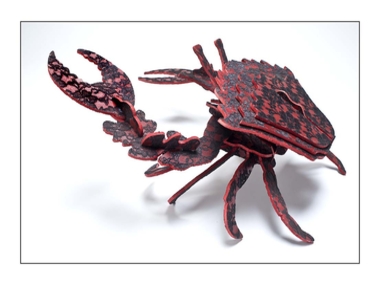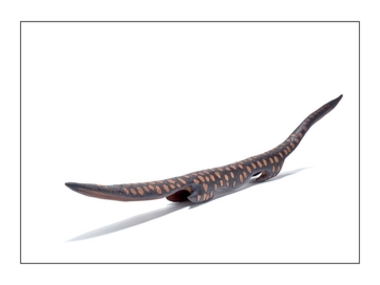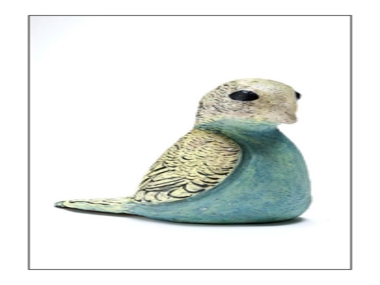MENAGERIE COMES BACK TO TOWN

Brian Robinson, Githalai (Crab), 2008. Courtesy the artist. Photo: Australian Museum
Posted by Jeremy Eccles | 11.09.09
Gallery: Australian Museum
Dates:
19.02.13
: 29.12.13
Menagerie is back in town! The 3-D show that began life in Sydney in 2009 spread across two venues - the Australian Museum and Object Gallery, has returned from its travels to Sydney. But it's all in one place this time - the Australian Museum's newly opened-up Indigenous Australians Gallery. What's more, they've bought the lot for their permanent collection - thanks to the Museum's Foundation.
Here's what I thought of it three and a half years ago:
We think of Aboriginal art primarily in terms of painting and abstraction. The land, the stories and even the Dreamtime characters – often people morphing into animals – are invariably represented on canvas or bark without figuration.
But indigenous art is always throwing up surprises. And now Sydney's Object Gallery – specialising in craft – and the Australian Museum have joined to curate a 33-artist show of 3-D creations which will tour the East coast for the next 3 years. The argument is that there are “rich object-making traditions” in the forms of weapons, shields, tools, containers, musical instruments and ceremonial items that have fed into an ethos in which “indigenous sculpture is on the increase”.
There are also women's weaving traditions – everything from mats to fish-traps – which have become sculptural and crossed the gender barrier as men weave animals out of recycled electric cable wire.
But there is no better example of the blending of old and new than Brian Robinson's Mud Crab (Gaithalai). This Kala Lagaw Ya man from Thursday Island in the Torres Strait has taken scarlet plastic sheets used for thongs, covered them in black lace, cut them into various crab parts and combined the pieces with the same delicate balancing skills that Senior TSI man Ken Thaiday uses to create his famous Shark head-dresses – also in the exhibition.
Another fascinating contrast of old and new can be found with the two Murray Cod created by Treahna Hamm and Yvonne Koolmatrie. The elder, Koolmatrie is famous for her meticulous weaving of sedge grasses from the Coorong – her Pondi (Murray Cod) clearly derived from timeless basket-making traditions. Hamm on the other hand has the ecological threat uppermost in her mind as she uses rubbish from the River to manufacture her chemical-green fish.
Pity that in Sydney the two cod are in different exhibition sites. Elsewhere, though, they'll swim side by side.
Arnhemland inevitably throws up the purely traditional highlight – with Blue Mud Bay's Djambawa Marawili's striking carved work giving three dimensional form to his bark masterwork called 'Metamorphosis of Baru' - the sacred crocodile. Man and animal are carved from the same tree, separated but morphing, and painted brilliantly too.
The completeness of this work might put much else in the shade, especially accompanied by Marawili's statement that he doesn't want people “only looking at pretty pictures any more; I want people to recognise our Law (in my works). It's all I can do”.
But the strength one can see in the survival of other artists on the scraps of the world – whether deeply buried roots of desert trees, barbed wire fences, rubbish-tip detritus troved on film by Badger Bates at Wilcannia or sheets of Tassie kelp – makes its point in the exhibition too. For instance, I've always tended to dismiss the hot-wire decoration on carved wooden animals from the Anangu people of the Western Desert as tourist-art. But the late Tjilpi Wara from Ernabella brings both spiritual and technical dimensions to his work that lift it right up out of the ordinary.
And the wisdom in the eyes of Judith Inkamala's big ceramic 'Budgie' brought to mind the importance of that bird in the education of young Aranda.
How much has the NATSIA Awards special Wandjuk Marika Prize for 3-D art encouraged this flowering? Several winners are present – Laurie Nilsen's barbed-wire emu, Janine McAullay Bott's courageous Frill-Neck Lizard, Dennis Nona here with a pair of bronze and aluminium sting-rays, Lena Yarinkura's mangy pandanus fibre camp-dogs, Craig Koomeeta's Cape York chunky carving, and this year's Big Telstra winner Danie Mellor – here showing politically-enhanced ceramic kangaroos.
Another thing worth noting is that Nona, Yarinkura and Koomeeta are just three of an increasing number of indigenous artists using the services of Brisbane's Urban Art Projects foundary to give their work a new, permanent form. Nona's dancing Stingrays are a peculiarly effective translation from the paper of his linocuts to sculpture.
And Menagerie will now stay in the refurbished Indigenous Gallery at the Australian Museum until the end of 2013.
URL: www.austmus.gov.au
Share this:
»  del.icio.us
»
del.icio.us
»  Digg it
»
Digg it
»  reddit
»
reddit
»  Google
»
Google
»  StumbleUpon
»
StumbleUpon
»  Technorati
»
Technorati
»  Facebook
Facebook
Contact Details
Gallery: Australian Museum
Telephone: +61 2 9320 6000
Address: 6 College Street Sydney Sydney 2010 NSW
Gallery: Australian Museum
Telephone: +61 2 9320 6000
Address: 6 College Street Sydney Sydney 2010 NSW

Tjilpi Wara, Ngintaka (Perentie Lizard), 2007. Courtesy the artist and Maruku Arts. Photo: Australian Museum

Judith Pungkarta Inkamala, Lurtijina (Budgie), 2008. Courtesy the artist, Hermannsburg Potters
Where is the exhibition?
Further Research
Gallery: Australian Museum
Artists: Badger Bates | Brian Robinson | Craig Koomeeta | Danie Mellor | Dennis Nona | Djambawa Marawili | Janine McAullay Bott | Judith Inkamala | Ken Thaiday | Laurie Nilsen | Lena Yarinkura | Marina Murdilnga | Penny Milingu Wanapuyngu | Tjilpi Wara | Treahna Hamm | Vicki West | Yvonne Koolmatrie
News Tags: Indigenous Sculpture | Menagerie | Object Gallery | pottery | weaving
Exhibition Archive
- 10.10.17 | TARNANTHI 2017
- 11.08.17 | Natsiaas 2017
- 20.07.17 | APY ART DOMINATES THE WYNNE
- 17.07.17 | Anangu Artist Wins $100,000 Prize
- 14.07.17 | The End of AAMU
- 11.07.17 | ART ACROSS THE COUNTRY
- 11.07.17 | TARNANTHI IN OCTOBER
- 05.07.17 | TJUNGUṈUTJA - from having come together
- 13.06.17 | Ghost-Nets Straddle the World
- 07.06.17 | Grayson Perry Going Indigenous?
- 05.06.17 | Barks Bigger than Ben Hur
- 27.05.17 | NGA QUINQUENNIAL 2017
- 21.05.17 | Blak Douglas Finds Home at the NGA
- 21.05.17 | BRIAN ROBINSON WINS HAZELHURST WOP
- 18.05.17 | PARRTJIMA 2.0
Advertising

